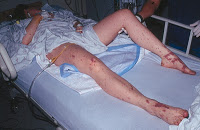
There are bad days and then there are really bad days. In many ways, the occurrence of septic shock is a culmination of a lot of bad things that can happen to you. Septic shock is the condition your body finds itself in as a result, progression and complication of a serious infection (The most common cause is pneumonia, but urinary tract and abdominal infections are also major causes.). This infection overwhelms your body, producing a massive inflammatory reaction, bringing many complications along. These complications include a significant drop in your blood pressure and can also include organ failure, most notably of the heart and lungs. Septic shock doesn’t occur to just anyone. It most often occurs in those with weakened immunity in one form or other (elderly, immunocompromised, diabetics, recent surgery, infection or prolonged hospital stay, burn victims, newborns and the pregnant), and it is the single most common cause of death in intensive care units in the U.S.
Signs and symptoms are routine and include low blood pressure, confusion or other signs of altered mental status, fever, chills and a fast heart rate, weakness, shortness of breath and noticeably diminished urination. Don’t focus on that list, though. Septic shock is a situation where your physician will know it when s/he sees it. If something like this happened at home, you’d recognize that something horrible was wrong, and you’d find yourself in an emergency room.
In terms of treatment, the ‘when’ is just as the important as ‘how’. The earlier this is diagnosed and treatment is started, the better chances of survival are. And let there be no doubt. Life is in the balance with this condition. Treatment simultaneously seeks to hold the patient up and support him/her while the underlying condition is being addressed. This is when the big guns are pulled in, including major antibiotics, intravenous fluids to rehydrate you, medications to support and enhance blood pressure and possible use of a breathing machine (ventilator) to ensure optimal oxygenation. Even surgery may be necessary to remove dead abdominal tissue, burn tissue or an abscess that may be the source of an infection.
The truth is septic shock carries a death (mortality) rate of 50%. It is always a bad situation and is best viewed as a medical miracle when survived as opposed to a treatment failure when death occurs. I can only wish you and your family the best if you find yourselves in this situation. Time is tissue.
Copyright © 2013 · Sterling Initiatives, LLC · Powered by WordPress

Reblogged this on AntiRadiation.
WOW. Scary.
Jeff,
As you may remember, I lost my dad to septic shock. His condition was a bewildering cascade of interventions and events in the ICU that I won’t forget anytime soon. I wouldn’t wish it on anyone.
Hi, Jonas. Absolutely. I only hope that others can avoid this fate. Thank you for sharing.